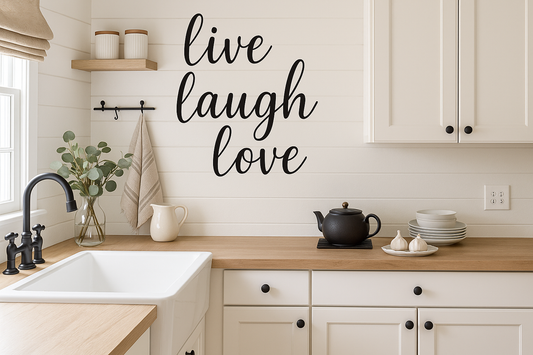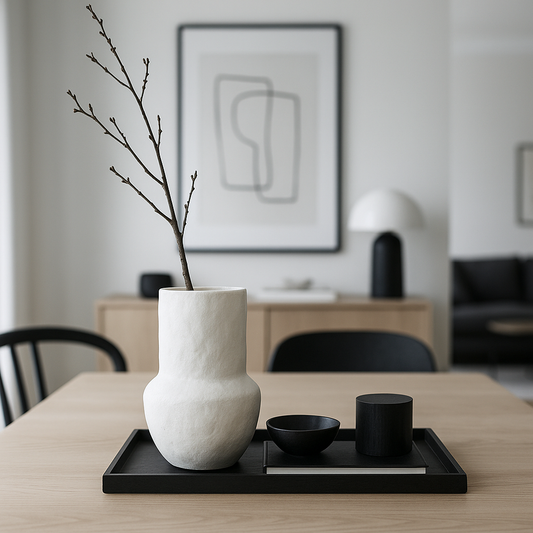The Art of Monochrome: How to Master Black and White Interior Styling
There’s a reason monochrome styling has stood the test of time. Black and white home decor is the ultimate power duo, combining elegance, versatility, and simplicity to create spaces that feel effortlessly chic. Whether you’re after high-contrast drama or serene sophistication, the monochrome aesthetic has you covered.
The beauty of this design style lies in its simplicity. By focusing on a single colour palette, you can create a cohesive and elegant space that radiates calm and clarity. But let’s be real: mastering monochrome isn’t as easy as slapping some black or white paint on your walls. It’s an art—one that, when done right, transforms any room into a haven of timeless style.
In this blog we will explore the essence of monochrome styling and discuss practical tips on how to master this stunning decorating style in your own home.
Why Monochrome Works So Well
Monochrome styling isn’t just about sticking to one colour—it’s about harmony, balance, and contrast. Black adds depth and drama, while white brings light and space. Together, they create tension and clarity in all the right ways.
But the magic really happens in the details. It’s the matte black hardware against crisp white cabinetry. The bold silhouette of a black statement chair in a sunlit room. The subtle layering of whites—ivory, cream, chalk, snow—each one adding its own nuance and warmth.
Tip 1: Mix Materials, Not Colours
In a monochrome space, texture is everything. Since you're not relying on bold colour, you'll need to create interest through materials. Think sleek black marble paired with boucle upholstery, matte black metal next to soft linen, or whitewashed timber contrasted with glossy ceramic.
This play on texture adds dimension and keeps the space from feeling flat. Don’t be afraid to layer rough with smooth, soft with structured—contrast doesn’t just apply to colour.
Tip 2: Use Negative Space Like a Pro
One of the biggest strengths of monochrome styling is how well it works with minimalism. But minimalist doesn’t mean empty. It means considered. Let your statement pieces breathe by giving them space. A black sculptural vase on a white plinth. A single line-drawing framed in black on a white wall. These moments shine when they’re not competing for attention.
Negative space creates calm. It allows your eye to rest and appreciate the composition. And in a black and white home, that restraint is where the luxury lives.
Tip 3: Add Subtle Warmth Through Accents
Yes, this is a monochrome home—but you don’t have to go full stark-and-clinical. Adding a few soft, warm neutral accents (think beige, greige, oat, or even tan) can bring life and subtle warmth to your black and white foundation.
Try incorporating:
- Natural timber pieces (pale or mid-tone work beautifully)
- Neutral-toned textiles (wool throws, linen cushions)
- Warm metallics like brass or bronze
- Black and white artwork with organic or earthy themes
These additions help prevent the space from feeling cold without disrupting the monochrome vibe.
Tip 4: Balance Bold Statements with Soft Edges
In monochrome styling, every piece makes a statement—so balance is key. If you’ve got strong architectural lines or bold furniture, soften them with curves, fabric, or subtle movement. A rounded black occasional chair. Billowing sheer white curtains. A soft rug under a black coffee table.
This combination of strength and softness makes your space feel elevated but still inviting.
Common Mistakes in Monochrome Styling
Even the most beautiful monochrome spaces can lose their magic if certain elements are overlooked. Here are a few things to avoid:
- Over-matching: Avoid making everything perfectly black or perfectly white. Too much uniformity can feel clinical. Instead, aim for balance and contrast.
- Ignoring undertones: Not all whites (or blacks) are created equal. Mixing warm and cool undertones without intention can disrupt the flow of your space.
- Neglecting lighting: Lighting is everything. Use warm, layered light sources to bring softness and highlight texture. Cold lighting can make monochrome interiors feel stark.
- Lack of scale variation: Mix large-scale pieces with smaller accessories. Contrast in size, not just colour, helps a room feel curated and dynamic.
Avoiding these common pitfalls will help your monochrome interiors feel sophisticated, not sterile.
FAQs About Black and White Styling
Q: Can I add other colours to a monochrome space?
A: Absolutely. Monochrome doesn’t mean “no colour ever”—it just means your base palette is black and white. Layer in soft neutrals, natural elements, or even subtle pops of colour (like muted olive or tan) for dimension.
Q: What’s the best wall colour for a monochrome room?
A: Warm whites or soft greys work beautifully. Avoid stark, blue-toned whites unless you're going for a hyper-modern look. A warm white gives the space depth while still feeling clean.
Q: Is monochrome styling good for small spaces?
A: Yes! The contrast of black and white can actually make a small space feel larger when balanced correctly. Use more white to open the room, and add black as a grounding element.
Final Thoughts
The art of monochrome styling is all about intentional simplicity. It’s not about playing it safe—it’s about creating bold, beautiful spaces through restraint, contrast, and care. Black and white interiors are timeless for a reason—and when layered with texture, form, and flow, they become anything but basic.
Monochrome homes have the power to feel serene, dramatic, minimal, and bold—all at once. With the right balance of texture, shape, space, and tone, you can create a space that feels calm, stylish, and unmistakably you.
✨ Ready to Style With Confidence?
Explore our curated collection of neutral homewares, styling kits, and free design resources to bring your monochrome vision to life.
Because timeless style doesn’t have to be complicated.



























